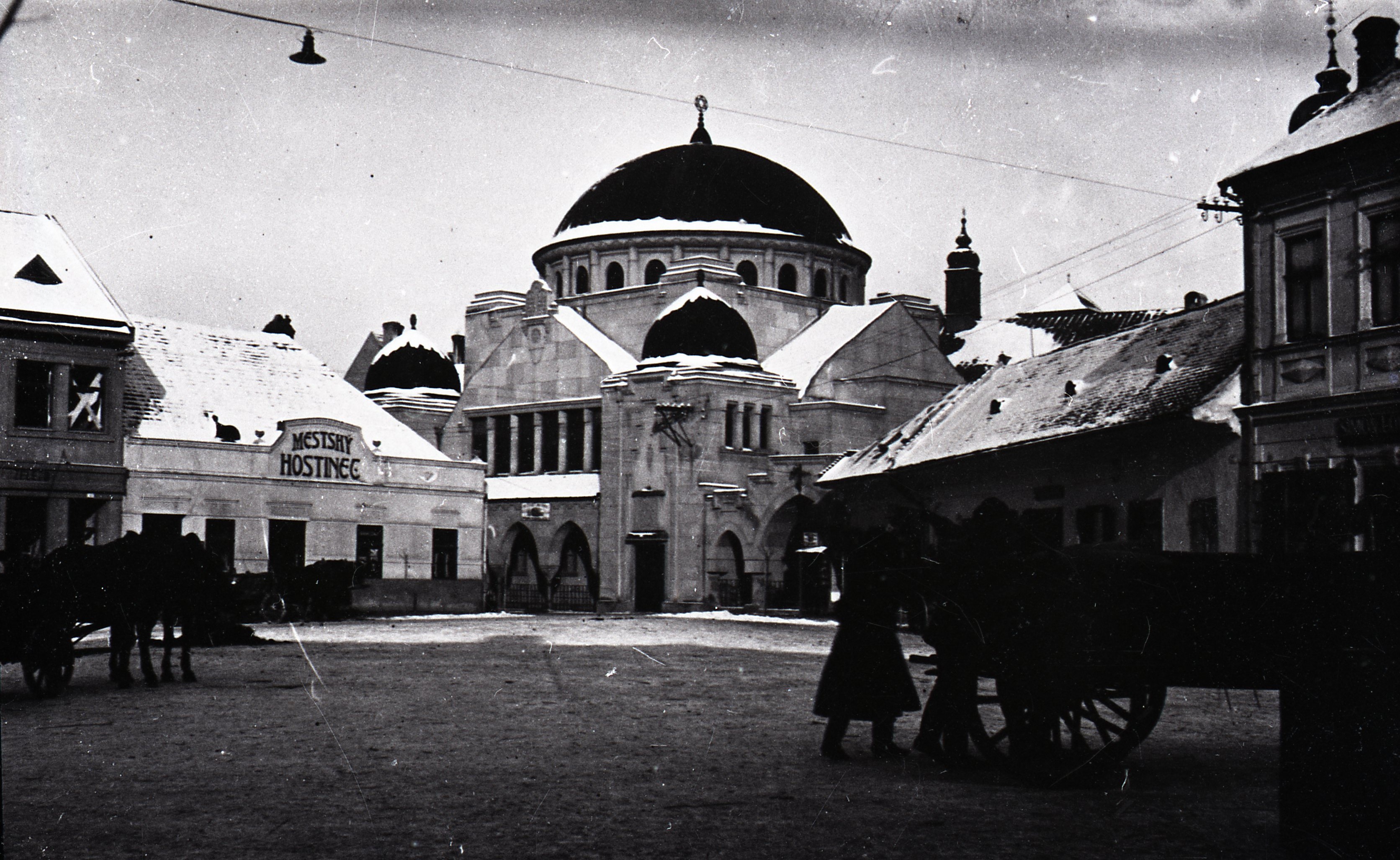
From 1911, information began to appear in the local Hungarian-German newspaper Vágvölgyi Lap related to the urgent need to build a new Jewish synagogue. After the general assembly of the Jewish community, led by its chairman Henrik Kácser, elected a new building committee on October 28, 1910, the search began for suitable land under the synagogue.
On March 5, 1911, the Jewish religious community bought land from Štefan Lange next to the original wooden synagogue for 10,000 crowns at the time. At the same time, the new construction committee organized a collection, to which the city of Trenčín also contributed, and the domestic electric participating company took part in the lighting of the future synagogue free of charge. On April 1, 1911, the Jewish youth of Trenčín organized a large art evening to support the construction of a new synagogue. As the newspaper Vágvölgyi Lap reported on April 9, 1911, the celebration exceeded the expectations of all involved with its atmosphere, high level, numerous participation of prominent artists and important personalities of the city. Throughout the period, the newspaper also published information on financial contributions and donations sent by individuals and companies to build the synagogue. Such an announcement was published, for example, on June 4, 1911, and we learn from it that the donors included the widow of Július Schlesinger of Trenčín, Filip Schlesinger Jr., Dr. Lichtenstein Salamon of Budapest or the Weiner Vilmos company.
On February 25, 1912, another announcement was published in the Vágvölgyi Lap newspaper concerning the construction of a new synagogue building in Trenčín. Based on the announcement in the local newspaper, the presidency of the Trenčín Jewish religious community called for public written tenders for the construction of a new synagogue, which were delivered directly to the chairman of the synagogue commission on March 10, 1912, Mr. Béla Friedmann, then director of the Trenčín Commercial and Industrial Bank. . The security was to represent 5% of the offered construction costs, which, however, should not exceed the amount of 150,000 crowns at the time. These costs were to include all planning, earthworks and masonry work, stone and wood cladding, roofing, carpentry, joinery, locksmithing, painting and glazing work, and the installation of sewerage and water supply pipelines. On March 24, 1912, the board of the Trenčín Jewish community subsequently published in the newspapers the names of the companies that presented their offers:
Trenčín company Béla Niegreisz and Albert Fuchs with wood and reinforced concrete construction in the amount of 135,054 crowns,
The company Karol Grün and son from Žilina with the amount of 149,746 crowns,
Armin Singer, a timber trader from Trenčín with a sum of 143,918 crowns,
The company Scholz and Materna from Trenčín with the amount of 127,853 crowns, with the exception of mosaics and painting on glass (this company operated in Trenčín in the first years of the 20th century),
The company Jozef Berta and Alfréd Kovács from Trenčín with the amount of 140,940 crowns (a major construction company that participated in the construction of several buildings in Trenčín and Piešťany, was forcibly liquidated in 1941 and Alfréd Kovács deported to a concentration camp),
Jozef Walla from Budapest with the amount of 7099 crowns for artificial stone and tiling work,
The first Trenčín factory for furniture and wooden goods with the amount of 20,194 crowns for delivery, resp. redesign of benches and counters.
According to the newspaper Vágvölgyi Lap on March 24, 1912, the building and organizing committee finally entrusted the management of the company to Béla Niegreisz and Albert Fuchs from Trenčín and chose the design of Richard Scheibner from Trenčín and his colleague Hugo Pál as the best project. Richard Scheibner, a young architect at the time, was just embarking on his career, and it was the cosmopolitan nature of his buildings that prompted the Jewish community to contract with him. R. Scheibner and his colleague had a huge synagogue built, following the example of some synagogues that were built in Germany at that time. Their cooperation ended with the First World War, Scheibner continued to work in Berlin, his later fate is unknown.
The cost of building a synagogue using modern building structures at the time was 160,000 crowns. The construction of the new synagogue took 18 months, the last services were held in the old synagogue on April 9, 1912. Vágvölgyi Lap on its pages on September 1, 1912. At the time of the construction of the new synagogue, Dr. Móric Diamant (1839-1913), who had an excellent religious and secular education and earned great respect and respect among the non-Jewish inhabitants of Trenčín. The new synagogue was inaugurated and consecrated on Tuesday, September 23, 1913 (21st elula 5673) at 3 p.m. The neological building of the synagogue is still one of the most beautiful and best-preserved architectural and historical monuments of its kind in Slovakia and was included in the project Slovak Way of Jewish Cultural Heritage.
Text author: Alica Krištofová
Source: Trenčín Museum
